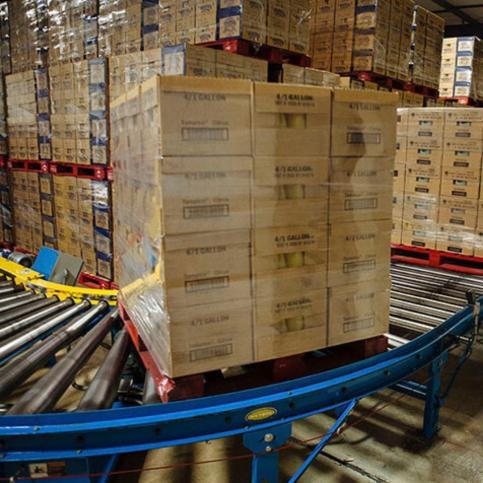
Different Types of Pallets and How They Affect Conveyor Operation
Conveyors are made to handle heavy-duty applications, dealing with pallets and cartons of products that can be both bulky and heavy. When it comes to deciding the kind of conveyor system to purchase, professional material handling solutions providers like Norpak Handling will ask our clients what kind of pallets they will be handling. It is important to get this information right as pallet type has a significant bearing on how a conveyor is to be operated in order to optimize results.
Firstly, let us go over the most common pallet types seen on conveyors:
1. Wood Pallets
This pallet type is probably the most familiar kind to most people. They are often constructed of GMA wood, with pieces fitted together with nails. They serve as a platform on which products can be stacked and arranged with stability. They generally have three to five bottom boards, which are the parts of the pallet making contact with the conveyor. Because these boards are spaced quite far apart, it is best to place these pallets on the conveyor with the boards running perpendicularly to the conveyor’s rollers to promote smooth conveyance and to allow rollers to be spaced further apart. If it is not possible to do this, you will have to outfit your conveyor with more rollers and ensure they are spaced close together. You can also use roller chains or flat running chains to give the pallets a more stable surface to sit on.
2. Plastic Containers
This kind of “pallet” poses challenges due to the wide variety of variations it has in design. Plastic containers can sometimes have completely smooth bottoms, distinct rail patterns or feature ribbed or honeycomb patterns. Plastic containers that have unusual patterns or a large number of patterns on their bottom surfaces can be more difficult to convey, particularly if the conveyor company you are working with does not have the skill to customize a solution for your needs. Generally, these kinds of complex designs require conveyors to have rollers with close centers, multiple strands of chain or a wide belted surface. We recommend our clients to avoid ball transfers as there is a potential for ball casters to get stuck in the ridges of the patterns.
3. Steel Racks
Like plastic containers, steel racks are markedly less uniform in design compared to wood pallets. There are two common types of steel racks: those with two steel runners and those that have “picture frame” bottoms. Depending on the design and construction of your steel racks, you may have to use roller chains or multiple lanes of narrow rollers as these options can provide more support and stability for “picture frame” steel racks. Powered rollers can also be used, but only if they are slightly wider than usual and are in extremely close centers. Because steel is such a strong material, there is also the potential for these racks to cause damages to your conveyor system. If you cannot avoid using steel racks, make sure you adopt a more intensive maintenance and inspection routine in order to ensure your conveyors stay in tip-top condition.
4. Plastic Pallets
Plastic pallets can be as easy to conveyor as wooden pallets, but only if they are constructed in the same way. There is a kind of plastic pallet that is especially difficult to convey: multi-footed plastic thermoform pallets. As their name implies, they are supported by “feet” or stumps made out of thermoform plastic. The surface area of each foot is not particularly wide, and the construction material is not as solid relative to the other pallet materials mentioned here. As such, special conveyor solutions are needed to ensure the stability of these pallets. The conveyor will need to have narrow tracks with small diameters and heavy gauge rollers on very close centers. Multiple strands of mat top plastic chains or tabletop chains can also be used, but only if the product weight is not too heavy.
The experts at Norpak Handling have seen many businesses run into problems by using the same conveyor system to convey drastically different kinds of products and packages. For professional guidance and advice, give Norpak Handling a call today. We will be happy to provide extensive consultations in order to ensure you choose the best conveyor system for your pallets.









